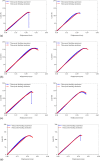Effects of different running intensities on the micro-level failure strain of rat femoral cortical bone structures: a finite element investigation
- PMID: 37700306
- PMCID: PMC10496390
- DOI: 10.1186/s12938-023-01151-6
Effects of different running intensities on the micro-level failure strain of rat femoral cortical bone structures: a finite element investigation
Abstract
Background: Running with the appropriate intensity may produce a positive influence on the mechanical properties of cortical bone structure. However, few studies have discussed the effects of different running intensities on the mechanical properties at different levels, especially at the micro-level, because the micromechanical parameters are difficult to measure experimentally.
Methods: An approach that combines finite element analysis and experimental data was proposed to predict a micromechanical parameter in the rat femoral cortical bone structure, namely, the micro-level failure strain. Based on the previous three-point bending experimental information, fracture simulations were performed on the femur finite element models to predict their failure process under the same bending load, and the micro-level failure strains in tension and compression of these models were back-calculated by fitting the experimental load-displacement curves. Then, the effects of different running intensities on the micro-level failure strain of rat femoral cortical bone structure were investigated.
Results: The micro-level failure strains of the cortical bone structures expressed statistical variations under different running intensities, which indicated that different mechanical stimuli of running had significant influences on the micromechanical properties. The greatest failure strain occurred in the cortical bone structure under low-intensity running, and the lowest failure strain occurred in the structure under high-intensity running.
Conclusions: Moderate and low-intensity running were effective in enhancing the micromechanical properties, whereas high-intensity running led to the weakening of the micromechanical properties of cortical bone. Based on these, the changing trends in the micromechanical properties were exhibited, and the effects of different running intensities on the fracture performance of rat cortical bone structures could be discussed in combination with the known mechanical parameters at the macro- and nano-levels, which provided the theoretical basis for reducing fracture incidence through running exercise.
Keywords: Back-calculation; Cortical bone; Micro-level failure strain; Running intensity; Three-point bending load.
© 2023. BioMed Central Ltd., part of Springer Nature.
Conflict of interest statement
The authors declare that they have no competing interests.
Figures






Similar articles
-
Prediction of the critical energy release rate for rat femoral cortical bone structure under different failure conditions.Comput Methods Programs Biomed. 2023 Dec;242:107873. doi: 10.1016/j.cmpb.2023.107873. Epub 2023 Oct 17. Comput Methods Programs Biomed. 2023. PMID: 37863011
-
Quantification of Age-Related Tissue-Level Failure Strains of Rat Femoral Cortical Bones Using an Approach Combining Macrocompressive Test and Microfinite Element Analysis.J Biomech Eng. 2016 Apr;138(4):041006. doi: 10.1115/1.4032798. J Biomech Eng. 2016. PMID: 26902102
-
Importance of asymmetry and anisotropy in predicting cortical bone response and fracture using human body model femur in three-point bending and axial rotation.J Mech Behav Biomed Mater. 2018 Nov;87:213-229. doi: 10.1016/j.jmbbm.2018.07.033. Epub 2018 Jul 25. J Mech Behav Biomed Mater. 2018. PMID: 30081355
-
Application of the Johnson-Cook plasticity model in the finite element simulations of the nanoindentation of the cortical bone.J Mech Behav Biomed Mater. 2020 Jan;101:103426. doi: 10.1016/j.jmbbm.2019.103426. Epub 2019 Sep 13. J Mech Behav Biomed Mater. 2020. PMID: 31557661 Review.
-
A Review on Multiscale Bone Damage: From the Clinical to the Research Perspective.Materials (Basel). 2021 Mar 5;14(5):1240. doi: 10.3390/ma14051240. Materials (Basel). 2021. PMID: 33807961 Free PMC article. Review.
Cited by
-
Development of a subject-specific finite element analysis workflow to assess local biomechanics during segmental bone defect healing.J Mech Behav Biomed Mater. 2025 Sep;169:107065. doi: 10.1016/j.jmbbm.2025.107065. Epub 2025 May 19. J Mech Behav Biomed Mater. 2025. PMID: 40449116
References
MeSH terms
Grants and funding
LinkOut - more resources
Full Text Sources
Medical

